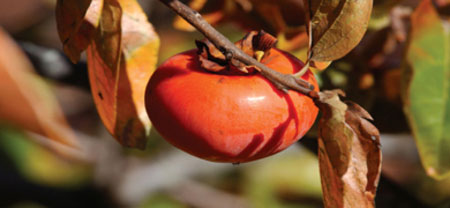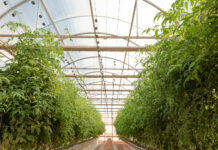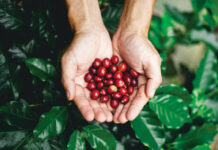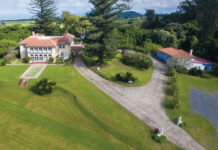Story and photography by Matthew Thayer
 Puffs of powder-dry red soil erupt with each step as young John Hashimoto makes a beeline through a field dotted with 500 spindly persimmon trees. His trembling arms burn from the weight of five-gallon water buckets clenched in each hand.
Puffs of powder-dry red soil erupt with each step as young John Hashimoto makes a beeline through a field dotted with 500 spindly persimmon trees. His trembling arms burn from the weight of five-gallon water buckets clenched in each hand.
Reaching a far corner of the farm where his father, Isami Hashimoto, kneels by a tree, working with sticks to prop it up straight, John picks a flat spot to set the buckets down. He is careful to not spill one drop of precious water, and then stoops quickly to grab the handles of a pair of empty pails. Isami Hashimoto takes note of his son’s heaving chest. “Help water these trees, then you go back for more,” he says.
Slowly, together, they pour water at the base of newly planted persimmons along Pulehuiki Road in Kula. The parched soil repels the life-giving liquid, at first, but as the ground moistens, it begins to drink the water in. The deliberate process gives John time to closely examine the trees that are causing him so much work. They seem so thin, the limbs so spare, it’s hard to imagine they will ever bear fruit.
Those sun-filled days on the bucket brigade were John Hashimoto’s earliest memories of the family’s five-acre farm. The trees planted in the early 1920s did indeed take root and grow. So much so, stout wooden frames now stand around each tree to help support the immense weight of the bright orange fruits as they ripen each fall.
Harvest time sees the trees’ leaves turn a blaze of reds, oranges and yellows worthy of a post card of New Hampshire in autumn. In November, island locals and nostalgic former Mainlanders travel out of their way to cruise ultra-steep Pulehuiki Road to get their yearly dose of fall colors. Old-timers will carpool up to the Hashimoto shed to buy boxes of ripe fruit and try new products like persimmon salad dressings, jams and butters.
There’s a Fuyu variety of persimmon you can buy there that looks like a tomato; it’s firm like an apple, and tastes a bit like a blend of pear and cantaloupe.
Native to China, persimmons have long been grown in Japan and Korea. That’s likely where Isami, son of Japanese immigrants, found the confidence to gamble his family’s future on 500 trees. Early in the twentieth century, Upcountry Maui was well settled by Japanese and Chinese immigrants, folks who would love to pay for a sweet taste of home.
Either Isami did his homework, or he got lucky, because Kula’s climate, altitude and soil have proven perfect to grow persimmons. Now, more than eighty years later, about 99 percent of all persimmons grown in the state of Hawai‘i come from the same square Kula mile, raised by the Hashimotos and a few of their neighbors.
The key for that success, however, goes way beyond soil pH and average temperatures. It travels all the way back to that boy carrying water buckets through a dusty field. John Hashimoto ended up dedicating his life to agriculture on Maui, cultivating not only his own farm’s success, but also helping other Upcountry farmers find ways to survive in the difficult business. John was one of the founding members of the Maui Farmers Cooperative. The cooperative still helps local farmers cut costs and remain competitive by buying supplies like packing boxes, seeds and other necessities in bulk.
John also spent a lifetime tending those persimmon trees—nurturing and trimming them, harvesting their fruit. Even last fall, at age at eighty-nine, he was still busy at the farm every day, usually turning a hand-cranked machine to peel hundreds of persimmons, one after another. He and wife Hanako often worked side by side in the processing shed, wearing flannel shirts against the Upcountry morning chill.
When the leaves turned red this fall, the fruit in the trees becoming so heavy the wooden frames groaned under the weight, it marked the first harvest at Hashimoto Farm without John’s steady effort and ready smile. After a long bout with lung cancer and other ailments, John Hashimoto died on May 7.
“We lost the old boss,” says son Clark Hashimoto. “When we were kids he was a disciplinarian. In our adult lives he mellowed down. He knew what to do and what to say, so we just sort of followed what he told us.”
Several years ago, John and Hanako were fortunate to turn the farm and its operations over to Clark and his wife, Jackie. While many island farmers retire to see their life work go the way of the bulldozer and developer when their kids don’t want to work the land, John and Hanako were assured their farm and its trees would continue to survive.
For Clark, it meant an opportunity to practice the agriculture techniques he preached for years as a County extension agent for the University of Hawai‘i College of Tropical Agriculture and Human Resources. His efforts have already seen results. Thanks to his improved care of the trees, the farm is preparing to harvest its third-straight bumper crop.
For Jackie, it is an opportunity to experiment with recipes for new products to complement her persimmon salad dressing, scone mix, dried fruit, butter and jam. The products give the farm a reach and flexibility to market in new ways and new areas like on the Mainland and over the Internet. The concoctions, each with bright new labels designed this year, have already drawn interest from as far away as New York and Japan.
“I’ve been trying to keep up with the times and to modernize,” Clark says. “We’ve been trying to develop products. We’ve expanded more to the O‘ahu markets with our value-added products and the persimmons.”
Each Hashimoto persimmon sold in island stores has a “Made on Maui” sticker.
“Consumers know it is a local product and they are willing to pay for the quality and the taste,” Clark says. “They do taste sweeter, better. The persimmons from the Mainland are picked pretty green.”
Like his father before him, Clark is dedicated to helping other farmers find ways to succeed. As this publication went to press, Maui Mayor Charmaine Tavares was scheduled name him the County’s new agriculture coordinator.
Clark says he would like to see some of the Maui children who have been fed, clothed and educated by the profits of their family farms come back to try their own hands at agriculture. He says that, while trying to start a Maui farm from scratch can be an expensive and difficult process, these kids have a chance.
“The land and everything else has to be affordable to start up,” he says. “A lot of the farmers do have sons. They have the equipment and they have the knowledge, but the kids go to college and say, ‘Why do I want to work so hard?’ A lot of them are quitting and taking jobs downtown.
“It’s a twenty-four/seven job and you are at the mercy of the weather, the prices and the competition. It’s hard work and it’s risky business.”
Persimmon farming is indeed hard work, but the trees planted more than eighty years ago give the Hashimotos a unique advantage that minimizes some risk. Unlike Upcountry cabbage farmers who may see prices drop out from under them if big O‘ahu growers flood the market, persimmons are a specialty item not grown commercially anywhere else in the state.
The Hashimotos ship fruit and products to a distributor on O‘ahu who markets them at stores and at the Kapiolani Community College Farmers Market. Demand is high. Long lines start forming before opening time to buy persimmons at the farmer’s market.
During harvest season in Kula, walk-in customers are welcome, as are school groups and hardy contingents from Kaunoa Senior Center. The family farm’s production shed is quaint and modest, but with sunlight filtering through its little square windows and the smell of fresh-picked fruit filling the chill air, it is chock-full of ambiance.
This year’s harvest begins in early November and is expected to continue through the first or second week of December. The first harvest without John Hashimoto will likely produce plenty of memories, both happy and sad. For his part, the “old boss” can rest easy, knowing that his trees continue to thrive and put food on the family’s table.
Hashimoto Persimmon Farm is located at 1378 Pulehuiku Road in Kula. For directions, call (808) 878-1461 or email hashimotc007@hawaii.rr.com. A website, www.hashimotopersimmons.com, is currently under construction and will soon make the farm’s products (aside from fresh fruit) available to order online.





